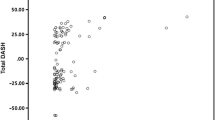Abstract
Background
Symptoms and psychosocial factors are suggested to account for more of the variation in disability than physical impairment, but perhaps less so at the level of specific tasks. This study assessed the influence of impaired wrist motion on specific tasks on the Disabilities of the Arm, Shoulder, and Hand (DASH) questionnaire.
Methods
Sixty-three patients with an operatively treated fracture of the distal radius completed the Pain Catastrophizing Scale (PCS), Pain Anxiety Symptoms Scale, and Center for Epidemiologic Studies Depression Scale (CES-D) just before surgery and the DASH questionnaire 3 months after surgery. Nine questions on the DASH were selected as potentially sensitive to changes in wrist motion and evaluated in bivariate and multivariable analyses.
Results
In multivariable models of factors associated with specific tasks, only “Open a tight or new jar” was affected by wrist flexion and PCS accounting for 33 % of the variation. Motion, pain, and PCS were significant predictors of the DASH score. Among the eight tasks not related to wrist motion, 33 % of the variation in disability with writing was accounted for by PCS and limb dominance; 20 % of disability preparing a meal by pain, CES-D, and PCS; 14 % of disability with making a bed by pain and CES-D; and 23 % of changing a light bulb overhead by age, pain, and fracture type.
Conclusions
After volar plate fixation of a fracture of the distal radius, upper extremity disability based on select items from the DASH questionnaire correlated minimally with impairment of wrist motion, even at the level of specific tasks.
Level of Evidence
Prognostic Level II.
Similar content being viewed by others
References
Adams BD, Grosland NM, Murphy DM, et al. Impact of impaired wrist motion on hand and upper-extremity performance(1). J Hand Surg Am. 2003;28:898–903.
Doornberg JN, Ring D, Fabian LM, et al. Pain dominates measurements of elbow function and health status. J Bone Joint Surg Am. 2005;87:1725–31.
Droll KP, Perna P, Potter J, et al. Outcomes following plate fixation of fractures of both bones of the forearm in adults. J Bone Joint Surg Am. 2007;89:2619–24.
Fracture and dislocation compendium. Orthopaedic Trauma Association Committee for Coding and Classification. J Orthop Trauma. 1996; 10 Suppl 1:v-ix, 1–154.
Hudak PL, Amadio PC, Bombardier C, et al. Development of an upper extremity outcome measure: the DASH (disabilities of the arm, shoulder and hand). Am J Indust Med. 1996;29:602–8.
Hunsaker FG, Cioffi DA, Amadio PC, et al. The American Academy of Orthopaedic Surgeons outcomes instruments: normative values from the general population. J Bone Joint Surg Am. 2002;84-A:208–15.
Karnezis IA, Fragkiadakis EG. Association between objective clinical variables and patient-rated disability of the wrist. J Bone Joint Surg Br. 2002;84-B:967–70.
Lindenhovius AL, Buijze GA, Kloen P, et al. Correspondence between perceived disability and objective physical impairment after elbow trauma. J Bone Joint Surg Am. 2008;90:2090–7.
MacDermid JC, Donner A, Richards RS, et al. Patient versus injury factors as predictors of pain and disability six months after a distal radius fracture. J Clin Epidemiol. 2002;55:849–54.
McCracken LM, Zayfert C, Gross RT. The pain anxiety symptoms scale: development and validation of a scale to measure fear of pain. Pain. 1992;50:67–73.
Nelson DL. Functional wrist motion. Hand Clin. 1997;13:83–92.
Pells J, Edwards CL, McDougald CS, et al. Fear of movement (kinesiophobia), pain, and psychopathology in patients with sickle cell disease. Clin J Pain. 2007;23:707–13.
Radloff LS. The CES-D scale: a self-report depression scale for research in the general population. Appl Psychol Meas. 1977;1(3):385–401.
Souer JS, Buijze G, Ring D. A prospective randomized controlled trial comparing occupational therapy with independent exercises after volar plate fixation of a fracture of the distal part of the radius. J Bone Joint Surg Am. 2011;93:1761–6.
Sullivan M. The pain catastrophizing scale: development and validation. Psychol Assess. 1995;7:525–32.
Tomaino MM, Miller RJ, Burton RI. Outcome assessment following limited wrist fusion: objective wrist scoring versus patient satisfaction. Contemp Orthop. 1994;28:403–10.
Vranceanu AM, Barsky A, Ring D. Psychosocial aspects of disabling musculoskeletal pain. J Bone Joint Surg Am. 2009;91:2014–8.
Vranceanu AM, Safren S, Zhao M, et al. Disability and psychologic distress in patients with nonspecific and specific arm pain. Clin Orthop Relat Res. 2008;466:2820–6.
Watson J, Ring D. Influence of psychological factors on grip strength. J Hand Surg Am. 2008;33:1791–5.
Wilcke MK, Abbaszadegan H, Adolphson PY. Patient-perceived outcome after displaced distal radius fractures. A comparison between radiological parameters, objective physical variables, and the DASH score. J Hand Ther. 2007;20:290–8. quiz 299.
Conflict of Interest
The authors declare that they have no conflict of interest related to this study.
Author information
Authors and Affiliations
Corresponding author
About this article
Cite this article
Bot, A.G.J., Souer, J.S., van Dijk, C.N. et al. Association between individual DASH tasks and restricted wrist flexion and extension after volar plate fixation of a fracture of the distal radius. HAND 7, 407–412 (2012). https://doi.org/10.1007/s11552-012-9447-8
Published:
Issue Date:
DOI: https://doi.org/10.1007/s11552-012-9447-8




